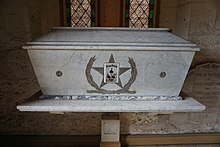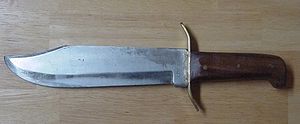James Bowie
Colonel James Bowie (/ˈbuːi/ BOO-ee[1][2][3])[a] (April 10, 1796 – March 6, 1836) was an American military officer, landowner and slave trader who played a prominent role in the Texas Revolution.
Stories of him as a fighter and frontiersman, both real and fictitious, have made him a legendary figure in Texas history and a folk hero of American culture.
What began as a duel between two other men deteriorated into a mêlée in which Bowie, having been shot and stabbed, killed the sheriff of Rapides Parish with a large knife.
[17] Raised on the frontier, the Bowie children worked from a young age, helping to clear the land and plant and cultivate crops.
[20] In late 1814, in response to General Andrew Jackson's plea for volunteers to fight the British in the War of 1812, James and Rezin enlisted in the Louisiana militia.
When the customs officers offered the slaves for auction, Bowie purchased them and received back half the price he had paid, as allowed by the state laws.
When the United States purchased the Louisiana Territory in 1803, it promised to honor all former land grant claims made to French and Spanish colonists.
Many craftsmen and manufacturers made their own versions, and major cities of the Old Southwest had "Bowie knife schools" that taught "the art of cut, thrust, and parry.
[51] In 1828, after recovering from the wounds he received in the Sandbar Fight, Bowie decided to move to Coahuila y Texas, at that time a state in the Mexican federation.
[53] Bowie was baptized into the Roman Catholic faith in San Antonio on April 28, 1828, sponsored by the alcalde (chief administrator) of the town, Juan Martín de Veramendi, and his wife, Josefa Navarro.
He stopped at Nacogdoches, at Jared E. Groce's farm on the Brazos River, and in San Felipe, where he presented a letter of introduction from Thomas F. McKinney, one of the Old Three Hundred colonists, to Stephen F. Austin.
[57] Although the Rangers would not be organized officially until 1835, Austin had founded the group by hiring 30 men to keep the peace and protect the colonists from attacks by hostile Native Americans.
[58] Bowie renounced his American citizenship and became a Mexican citizen on September 30, 1830, after promising to establish textile mills in the state of Coahuila y Tejas.
[61] On April 25, 1831, Bowie married nineteen-year-old Maria Ursula de Veramendi, the daughter of his business partner, who had become the vice governor of the province.
Several days before the ceremony, he signed a dowry contract promising to pay his new bride 15,000 pesos (approximately $15,000 then, or $429,000 today[62]) in cash or property within two years of the marriage.
[65] After obtaining permission from the Mexican government to mount an expedition into Indian territory to search for the legendary silver mine, Bowie, his brother Rezin, and ten others set out for San Saba on November 2, 1831.
[69] Captain William Y. Lacey, who spent eight months living in the wilderness with Bowie, described him as a humble man who never used profanity or vulgarities.
In response to the rumblings, Mexican troops established military posts in several locations within the province, including San Antonio de Béxar.
[74] In July 1832, after hearing that the Mexican army commander in Nacogdoches, José de las Piedras, had demanded that all residents in his area surrender their arms, Bowie cut short a visit to Natchez to return to Texas.
Fearing the disease would reach San Antonio, Bowie sent his pregnant wife and their daughter to the family estate in Monclova, in the company of her parents and brother.
His appointment ended in May 1835, when President Antonio López de Santa Anna abolished the Coahuila y Tejas government and ordered the arrest of all Texans (including Bowie) doing business in Monclova.
Bowie visited several Native American villages in East Texas in an attempt to persuade the reluctant tribes to fight against the Mexican government.
[78] One of the men under Bowie's command during the battle later praised him "as a born leader, never needlessly spending a bullet or imperiling a life, who repeatedly admonished... Keep under cover boys, and reserve your fire; we haven't a man to spare.
[90] Houston knew that there were not enough men to hold the fort in an attack, and he gave Bowie authority to remove the artillery and blow up the fortification.
After learning that Santa Anna had 4,500 troops and was heading for the city,[91] Bowie wrote several letters to the provisional government asking for help in defending the Alamo, especially "men, money, rifles, and cannon powder".
[92] In another letter, to Governor Smith, he reiterated his view that "the salvation of Texas depends in great measure on keeping Béxar out of the hands of the enemy.
[94] Bowie celebrated his appointment by getting very drunk and causing havoc in San Antonio, releasing all prisoners in the local jails and harassing citizens.
[105][106] On February 26, Crockett reported that Bowie, though suffering from his condition, continued to crawl from his bed around noon every day and present himself to the Alamo's inhabitants, which much boosted the morale of his comrades.
A newspaper article claimed that a Mexican soldier saw Bowie carried from his room on his cot, alive, after the conclusion of the battle.
"[117] According to Wallace O Chariton, the "most popular, and probably the most accurate"[4] version is that Bowie died on his cot, "back braced against the wall, and using his pistols and his famous knife.






